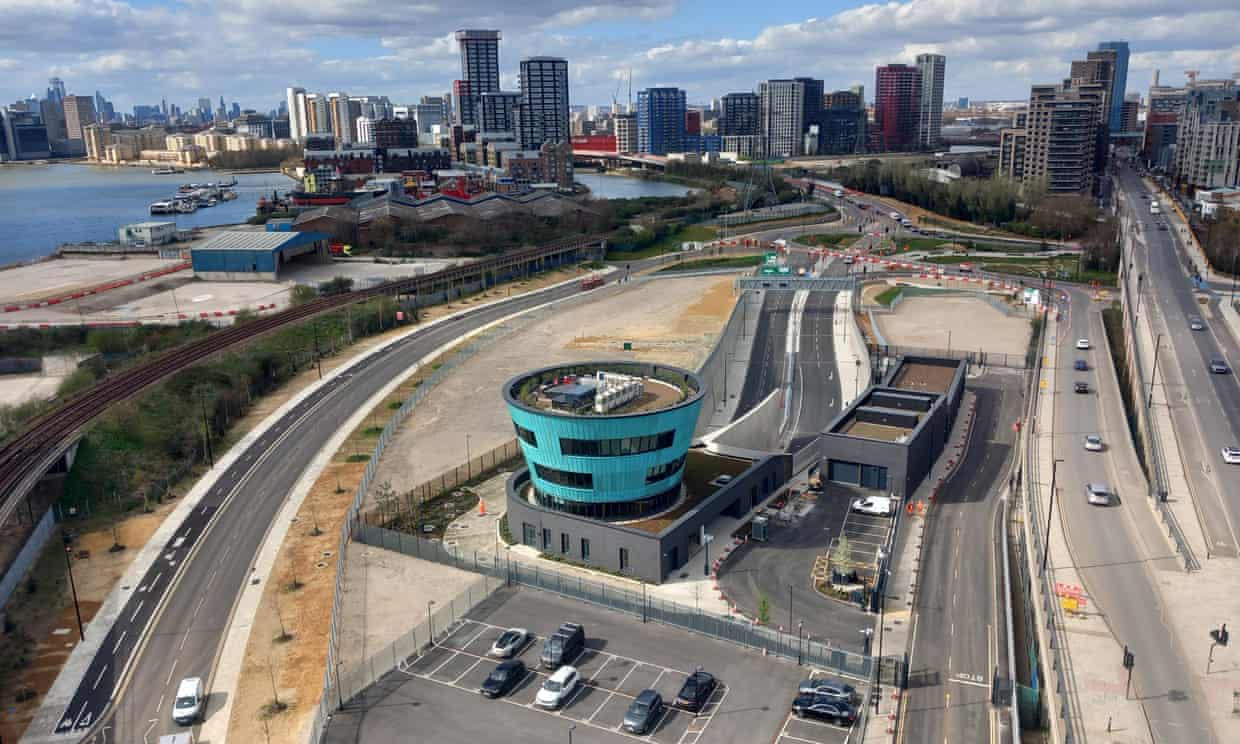**Aerial views of the Thames reveal the striking entrances of the new Silvertown tunnel: a black archway on the North Greenwich peninsula contrasting with a green conical structure a mile away in Newham.**
On Monday, a flood of vehicles, including cars and trucks, is set to traverse this new route, just beneath the cable car established during Boris Johnson’s tenure, as if following an enigmatic ley line that compels London mayors to engage in controversial transportation initiatives.
The Silvertown tunnel, a 0.9-mile project costing £2.2 billion located in an area that is already one of London’s most polluted regions, doesn’t seem like an evident choice for advocacy by Sadiq Khan, the current City Hall incumbent – known primarily for expanding the ultra-low emission zone (Ulez) with the aim of enhancing air quality.
However, there has seldom been a perfect solution for improving cross-river connections east of the City, ranging from the Woolwich ferry to the long-delayed mega-project of the Lower Thames Crossing. According to Transport for London (TfL), the Silvertown link will alleviate congestion at the nearby, heavily trafficked Blackwall tunnel and reduce pollution by addressing the daily 20-minute delays that plague both buses and cars trying to cross the Thames.
Currently, around 100,000 vehicles traverse the Blackwall tunnel daily, with an anticipated 25,000 set to use Silvertown once it opens on April 7th. Transport advocates have long argued that new roadways tend to increase traffic volumes, and TfL concurs that, in the absence of tolls, Silvertown would redirect many drivers from using the Dartford crossing.
**This endeavor, originally conceived in the 1990s, is now being realized three decades later.**
Starting Monday, both Silvertown and the previously toll-free Blackwall tunnel will impose fees of up to £4 per trip for cars. Discounts will apply during off-peak hours for those who enroll in TfL’s automatic payment system, while low-income residents and businesses may qualify for additional concessions. Nonetheless, the mayor has pointed out the disparity between river crossings in East and West London, where only drivers in less affluent neighborhoods are subject to crossing fees.
TfL expects to generate over £100 million annually from tolls, sufficient to cover the private finance initiative (PFI) contract for building, operating, and maintaining the tunnel, awarded to the Riverlinx consortium for a 25-year duration. The agency emphasizes that the primary goal is to manage the traffic that might otherwise flock to a free tunnel rather than be deterred by congestion.
This rationale appears puzzling to local critics, with even the mayor’s office seeming conflicted: praising the tunnel’s benefits while underscoring that its plans were laid out by his predecessor, Johnson.
In a rare accomplishment, Silvertown is on track to be completed on schedule and within budget. Khan declared it will “revolutionize travel in the southern and eastern parts of our city, particularly across the River Thames.”
“It promises quicker, more dependable journey times for thousands of Londoners, diminished congestion, and improved air quality, along with enhanced public transport options through zero-emission cross-river buses,” he asserted.
He noted, “The original designs for the Silvertown tunnel were initiated in 2012. We have implemented numerous enhancements to make the project more environmentally friendly and to introduce measures that support Londoners, neighboring residents, and businesses.”
“This includes providing discounts and concessions, as well as, for the first time, allocating a lane exclusively for zero-emission double-decker buses and a groundbreaking free bicycle-shuttle service to promote a shift towards greener transport options.”
Such optimistic claims have sparked outrage among opponents: while the £2 million cycle-shuttle service will be complimentary for the initial year, the tunnel facilitates access for larger trucks previously barred from the Blackwall tunnel. These heavy goods vehicles will also utilize the bus lane.
Tolls will not apply to any vehicle after 10 PM. Victoria Rance, the founder of the Stop the Silvertown Tunnel Coalition, stated: “There’s no all-night crossing for bicycles east of Tower Bridge, yet they are promoting a free nighttime crossing for HGVs. They’re encouraging these trucks at night when people are trying to sleep.”
Rance traveled on her e-bike along the newly accessible zigzag ramps of the pedestrian bridge at Boord Street on the Greenwich peninsula, a fresh yellow steel-mesh structure designed to span the new southern roads of the tunnels. Residents of the housing developments to the west now find themselves divided from local schools by ten lanes of traffic.
From this vantage point, the collective concerns become clearer. Even during the day, traffic is at a standstill; however, this side of the road has, until recently, been free of large trucks, according to Rance. The northbound Blackwall tunnel, a late-Victorian structure, has a height limitation of 13 feet (4 meters); nevertheless, larger trucks frequently emerge from the more spacious southbound tunnel, added in 1967.
Starting Monday, though, heavy goods vehicles will be allowed to take the neighboring Silvertown tunnel for northbound crossings. “Once it becomes bidirectional, it’s their new route,” Rance remarked. “The pollution is already unbearable. And the speed at which they come through makes it incredibly dangerous.”
Rance has expressed remorse for the air quality her now-adult children had to contend with while living near the A102: “I respect Sadiq Khan for his Ulez initiative, but this feels like a significant backward step,” she explained. “Across Europe, infrastructure is being developed for trams, bicycles, and buses. This project, originating in the 1990s, is finally coming to life 30 years later.”
TfL argues that London’s HGVs are cleaner and safer than in the past – the tunnels are within the Ulez boundaries, mandating compliance with its Safer Lorry Scheme. They promise roadside monitoring, and according to David Rowe, TfL’s director of investment delivery planning, “Our assessments indicate that air quality will improve overall – and we’ve made a legal commitment to ensure that happens.”
Rowe added: “If we were merely constructing a road tunnel, we would anticipate an increase in traffic. That’s why we sought the authority to implement user charges, alongside the introduction of new bus services.”
Double-decker buses will be able to traverse the tunnel, becoming part of the Superloop express service, with zero-emission buses operating here for free during the first year. Electric taxis and minicabs will not incur any tolls.
“I understand why there would be concerns regarding the potential increase in HGVs, but that’s absolutely not our intention,” Rowe clarified. “We’ve set the charges at a level [£10 per lorry] designed to prevent any additional traffic influx.”
For advocate Dominic Leggett, the reasoning is unclear: “TfL needs to demonstrate that, considering the tolls at Blackwall, the addition of the tolled Silvertown tunnel will lead to quantifiably improved economic and environmental outcomes that justify the expenditure of billions.”
Despite multiple inquiries, he stated: “They have never provided this evidence. If they could substantiate substantial benefits, there would be no reason to withhold the information. Therefore, we assume they cannot.”
Meanwhile, some independent analysts are optimistic about the project. “Considering the failure of three levels of government to resolve the issues with Hammersmith Bridge, this is a testament to effective public procurement, ingenuity, and successful delivery,” noted professor Tony Travers, director of LSE London. “While road expansion is not widely praised nowadays, it shouldn’t be dismissed outright.
“This will also enhance public transport to areas that remain relatively disadvantaged; it represents an economic opportunity. Constructing infrastructure that can self-finance through fees or tolls is a logical approach.”

